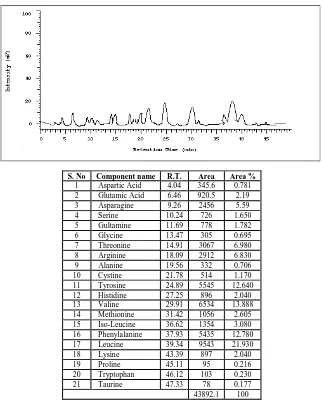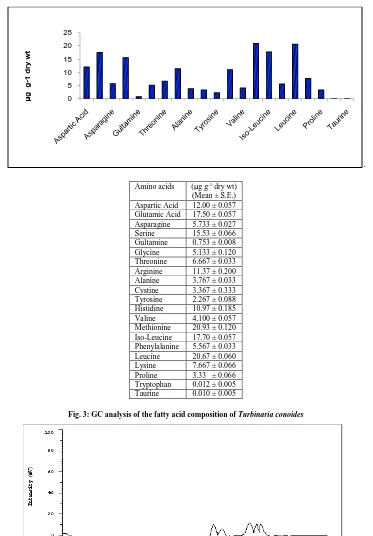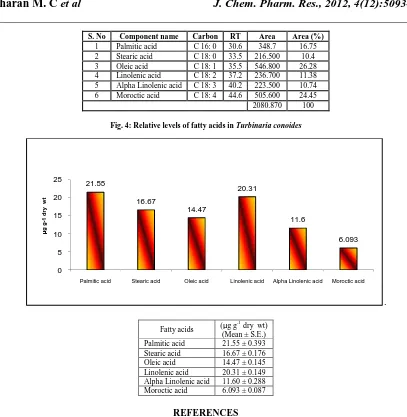Journal of Chemical and Pharmaceutical Research, 2012, 4(12):5093-5097
Research Article
CODEN(USA) : JCPRC5
ISSN : 0975-7384
Amino acids and fatty acids in Turbinaria conoides
Sridharan M. C.
1and Dhamotharan R
21
Department of Plant Biology and Plant Biotechnology, The New college, (autonomous) Chennai
-600 014, India.
2
PG and Research Department of Plant Biology and Plant Biotechnology, Presidency College,
Chennai 600 005, India.
_____________________________________________________________________________________________
ABSTRACT
Amino acids and Fatty acids of Turbinaria conoides were determined. Amino acids were estimated by HPLC methods where as fatty acids by gas chromatography. Total twenty one amino acids were found in the dried sample, methionine is the major constituent and followed by leucine, iso-leucine, glutamic acid and serine. In the case of fatty acids, six components were identified. Palmitic acids are found to be the major constituent. As a result, this present study results showed that Turbinaria conoides in the Mandapam could be utilized as functional ingrediental for the valuable nutritional properties for seafood industries.
Key words: Seaweeds, Turbinaria conoides, Amino acids and Fatty acids.
_____________________________________________________________________________________________
INTRODUCTION
Seaweeds or marine macrophytic algae are an assemblage of the members of Chlorophyceae, Phaeophyceae and Rhodophyceae and are the common inhabitants of the tidal and intertidal environments of the marine ecosystem. Marine algae are exploited mainly for the industrial production of phycocolloids such as agar-agar, alginate and carrageenan. Seaweeds have some of the valuable medicinal value components such as antibiotics, laxatives, anticoagulants, anti-ulcer products and suspending agents in radiological preparations. Fresh and dry seaweeds are extensively consumed by people, especially living in the coastal areas. The edible seaweeds contain a significant amount of the proteins, vitamins and minerals for human nutrition [1].
Seaweeds are regular part of human diet in coastal China since 1850 [2] and even today they are mainly consumed in the orient and pacific islands. Food value, flavour, colour and texture appear to favour the use of seaweeds as food. Nevertheless, marine algae can serve as a source of minerals, vitamins, free amino acids and polyunsaturated fatty acids. The use of algal oils containing Long Chain Polyunsaturated Fatty Acids (LCPUFAs) as nutritional supplements has been recommended [3] and algal sources are being identified for the presence of Docosahexaenoic Acid (DHA) and Eicosapentanoic Acid (EPA).
In general, from the critical review of literature, it has been observed that the most studies on the nutrient contents of seaweeds have concerned fresh plant. Little is known of the effects of processing by drying. The present investigation aims at on the following fromTurbinaria conoides.
______________________________________________________________________________
EXPERIMENTAL SECTION
Sample was collected from the sea coast of Mandapam, Tamil Nadu, India in the form of dry sample. Algal sample were cleaned at epiphytes and necrotic parts were removed. Sample was rinsed with sterile water to remove any associated debris. Sample was kept under sunshade for 7 days. After drying the powder was then used the primary estimation of amino acids and fatty acids. This powder was stored in cold conditions in an airtight container and analysis was carried out within three months of processing.
Qualitative and Quantitative Estimation of Amino acids
Free and protein bound amino acids were estimated by O-pthaldialdehyde method described by Rajendra [4].
Estimation of Fatty acids
Fatty acids in the sample were identified and quantified methyl esters in NEON II gas chromatography instrument following the procedure outlined by Niller and Berger [5].
Statistical Analysis
Data were analyzed using expressed in Mean ± S.E. Statistical analyses were performed using graph pad prism for windows (Graph Pad vision 4, San Deigo, CA).
RESULTS AND DISCUSSION
Amino acids
The dried sample of Turbinaria conoides was found to contain 21 amino acids, namely, aspartic acid, glutamic acid, asparagine, serine, gultamine, glycine, threonine, arginine, alanine, cystine, tyrosine, histidine, valine, methionine, iso-leucine, phenylalamine, leucine, lysine, proline, tryptophan and taurine. (Figs 1& 2). In Turbinaria conoides the concentration of methionine was (20.93 µg g-1 dry wt) follows by leucine (20.67 µg g-1 dry wt), iso-leucine (17.70 µg g-1 dry wt), glutamic acid (17.50 µg g-1 dry wt) and serine (15.53 µg g-1 dry wt)(Fig. 2).
Giuseppe Impellizzeri et al. [6] quantitatively determined free protein amino acids in 30 red algae. In most of the species, aspartic acid, asparagine, glutamic acid, glutamine, alanine, glycine and serine were abundant, while massive accumulation of proline (up to 80.5%) was observed in six species, of the family Rhodomelaceae. Dave and Chauhan [7] have reported high levels of lysine (169.8 µ g g-1 dry wt) in the tissues of Caulerpa sp. The observed level of lysine in Padina is more than that reported from the fresh water alga Spirulina [8-9]. In general, the amino acid profile is important for evaluating the nutritional value of algae proteins, but the digestibility of algae protein was not analysed. Christine Dawezynski et al. [10] examined different seaweed products for Analysis of Amino Acids (AAs), protein and dietary fibre. All essential AAs were detected in the seaweed species tested and red algae species featured uniquely high concentrations of taurine when compared to brown algae varities. Rajasulochana et
al., [11] reported the dried sample of Kappaphycus alvarezi was found to contain 18 amino acids. The lysine was the
major constituent followed by phenylalanine, glutamic acid, isoleucine, histidine, trytophan, methonine and asparagine. Further, it can be noted that glycine is much less quantity compared to all other components available in
Kappaphycus sp.
Fatty Acids
The shade dried powdered sample of Tubinaria conoides was found to contain 6 fatty acids namely, palmitic acid, stearic acid, oleic acid, linolenic acid, alpha linolenic acid and moroctic acid (Figs.3 & 4). In Turbinaria conoides the concentration of palmitic acid (21.55 µg g-1 dry wt) followed by linolenic acid (20.31 µg g-1 dry wt) (Fig.4).
Dembitsky et al. [12] have examined the fatty acid content of the brown algae of black sea and found 16:0, 18:1, 18:3, 18:4 and 20:5 fatty acids were found to be predominant. An investigation on the fatty acid content of Padina
gymnospora from Indian coast has shown the presence of only nine fatty acids with palmitic acid as the major
constituent and the absence of lauric acid in the alga is notable and distinct [13]. Rajasulochana et al. [11] analysed eight fatty acids components in Kappaphycus alvarezi.
______________________________________________________________________________
[image:3.595.136.458.165.584.2]of six fatty acids. In Turbinaria conoides, palmitic acid was the major constituent. Therefore, the result of the study has demonstrated that marine plant in the Mandapam could be used as ingredient in functional foods for human consumption.
Fig 1: D-7000 HPLC analysis of the amino acid composition of Turbinaria conoides
S. No Component name R.T. Area Area %
1 Aspartic Acid 4.04 345.6 0.781
2 Glutamic Acid 6.46 920.5 2.19
3 Asparagine 9.26 2456 5.59
4 Serine 10.24 726 1.650
5 Gultamine 11.69 778 1.782
6 Glycine 13.47 305 0.695
7 Threonine 14.91 3067 6.980
8 Arginine 18.09 2912 6.830
9 Alanine 19.56 332 0.706
10 Cystine 21.78 514 1.170
11 Tyrosine 24.89 5545 12.640
12 Histidine 27.25 896 2.040
13 Valine 29.91 6534 13.888
14 Methionine 31.42 1056 2.605
15 Iso-Leucine 36.62 1354 3.080
16 Phenylalanine 37.93 5435 12.780
17 Leucine 39.34 9543 21.930
18 Lysine 43.39 897 2.040
19 Proline 45.11 95 0.216
20 Tryptophan 46.12 103 0.230
21 Taurine 47.33 78 0.177
______________________________________________________________________________
Fig. 2: Relative levels of amino acids in Turbinaria conoides
.
Amino acids (µg g-1 dry wt)
(Mean ± S.E.) Aspartic Acid 12.00 ± 0.057 Glutamic Acid 17.50 ± 0.057 Asparagine 5.733 ± 0.027
Serine 15.53 ± 0.066
Gultamine 0.753 ± 0.008
Glycine 5.133 ± 0.120
Threonine 6.667 ± 0.033
Arginine 11.37 ± 0.200
Alanine 3.767 ± 0.033
Cystine 3.367 ± 0.333
Tyrosine 2.267 ± 0.088
Histidine 10.97 ± 0.185
Valine 4.100 ± 0.057
Methionine 20.93 ± 0.120 Iso-Leucine 17.70 ± 0.057 Phenylalanine 5.567 ± 0.033
Leucine 20.67 ± 0.060
Lysine 7.667 ± 0.066
Proline 3.33 ± 0.066
Tryptophan 0.012 ± 0.005
[image:4.595.136.455.529.687.2]Taurine 0.010 ± 0.005
Fig. 3: GC analysis of the fatty acid composition of Turbinaria conoides
0 5 10 15 20 25
µµµµ
g
g
-1
d
ry
w
______________________________________________________________________________
Fig. 4: Relative levels of fatty acids in Turbinaria conoides
.
Fatty acids (µg g
-1 dry wt)
(Mean ± S.E.)
Palmitic acid 21.55 ± 0.393
Stearic acid 16.67 ± 0.176
Oleic acid 14.47 ± 0.145
Linolenic acid 20.31 ± 0.149 Alpha Linolenic acid 11.60 ± 0.288
Moroctic acid 6.093 ± 0.087
REFERENCES
[1] Mohamed Fayaz, Namitha KK, Chidambara Murthy KN, Mahadeva Swamy M, Sarada R, Salma Khanam, Subbarao PV, Ravishankar GA, J. Agric. Food Chem., 2005, 53, 792 - 797.
[2] Waaland, J. R, Seaweeds as fertilizers. In: Biology of seaweeds Eds Lobban, C.S., I I and Wynne, M. J. Blackwell Scientific Publishers. Oxford.1981, pp 729
[3] Calder, P.C. and Grimble, R.F., Journal of Clinical Nutrition. 2002, 56, 14-19. [4] Rajendra, N., J. liquid chr., 1987, 10, 941 - 954.
[5] Niller, S. and Berger, T., Hewlet Packard Application note. 1985, pp. 228 - 241.
[6] Giuseppe Impellizzeri, Sebastiano Mangiafica, Mario Piattelli and Sebastiano Sciuto., Biochemical Systematics
and Ecology., 1977, 5, 77 - 80.
[7] Dave, M. J. and Chauhan, V. D., Phykos., 1993, 32, 21 –26.
[8] Becker, E.W. and Venkataraman, L. V. Microalgae: Biotechnology and Microbiology. Cambridge University Press. Cambridge., 1994, pp 238 - 239.
[9] Venkatraman, L. V., A monograph on Spirulina platensi. Biotechnology and application, CFTRI, Mysore, India.
1983.
[10] Christine Dawczynski, Rainer Schubert, Gerhard Jahreis, Food Chemistry., 2007, 103, 891 - 899.
[11] Rajasulochana, P., Krishnamoorthy, P and Dhamotharan, R. ARPN J. of Agr. and Bio. Scie., 2010, 5, 1 - 12. [12] Dembitsky, V. M., Rozentsvet, D. A. and Pechenkina, E. E. Phytochemistr ,. 1990, 29, 3417 - 3421.
[13] Rao, P. S. Reptr., 1989, 8, 23 - 27. 21.55
16.67
14.47
20.31
11.6
6.093
0 5 10 15 20 25
Palmitic acid Stearic acid Oleic acid Linolenic acid Alpha Linolenic acid Moroctic acid
µµµµ
g
g
-1
d
ry
w
t
S. No Component name Carbon RT Area Area (%)
1 Palmitic acid C 16: 0 30.6 348.7 16.75
2 Stearic acid C 18: 0 33.5 216.500 10.4
3 Oleic acid C 18: 1 35.5 546.800 26.28
4 Linolenic acid C 18: 2 37.2 236.700 11.38
5 Alpha Linolenic acid C 18: 3 40.2 223.500 10.74
6 Moroctic acid C 18: 4 44.6 505.600 24.45


